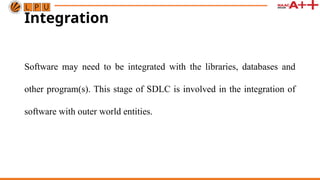software evelopment life cycle model and example of water fall model
- 2. 1. Development process looks like the flow 2. Gradual execution of every stage completely 3. Strictly documented and predefined with features expected to every phase
- 4. Requirement Gathering • studying the existing or obsolete system and software, • conducting interviews of users and developers, • referring to the database or • collecting answers from the questionnaires.
- 5. Feasibility Study • The team analyzes if a software can be made to fulfill all requirements of the user and if there is any possibility of software being no more useful. • The project is financially, practically and technologically feasible for the organization to take up.
- 6. System Analysis 1. System analysis includes Understanding of software product limitations, 2. learning system related problems or changes to be done in existing systems beforehand 3. Identifying and addressing the impact of project on organization and personnel etc.
- 7. Software Design • Inputs from users and information gathered in requirement gathering phase are the inputs of this step. • The output of this step comes in the form of two designs; logical design and physical design. • Engineers produce meta-data and data dictionaries, logical diagrams, data-flow diagrams and in some cases pseudo codes.
- 8. Coding • writing program code in the suitable programming language and developing error-free executable programs efficiently.
- 9. Testing Software testing is done while coding by the developers and thorough testing is conducted by testing experts at various levels of code such as module testing, program testing, product testing, in-house testing and testing the product at user’s end
- 10. Integration Software may need to be integrated with the libraries, databases and other program(s). This stage of SDLC is involved in the integration of software with outer world entities.
- 11. Deployment Means installing the software on user machines. At times, software needs post-installation configurations at user end.
- 12. Operation and Maintenance The software is maintained timely by updating the code according to the changes taking place in user end environment or technology. This phase may face challenges from hidden bugs and real-world unidentified problems.
- 13. Disposition 1. As time passes, the software may decline on the performance front. 2. It may go completely obsolete or may need intense upgradation. 3. This phase includes archiving data and required software components, closing down the system, 4. Planning disposition activity terminating system at appropriate end- of-system time.
- 14. Waterfall SDLC Model ADVANTAGES DISADVANTAGES Simple to use and understand The software is ready only after the last stage is over Management simplicity thanks to its rigidity: every phase has a defined result and process review High risks and uncertainty Development stages go one by one Not the best choice for complex and object- oriented projects Perfect for the small or mid-sized projects where requirements are clear and not equivocal Inappropriate for the long-term projects Easy to determine the key points in the development cycle The progress of the stage is hard to measure while it is still in the development Easy to classify and prioritize tasks Integration is done at the very end, which does not give the option of identifying the problem in advance














